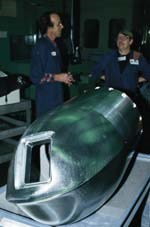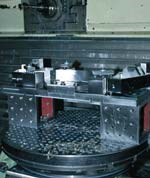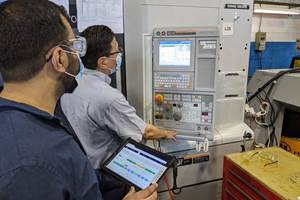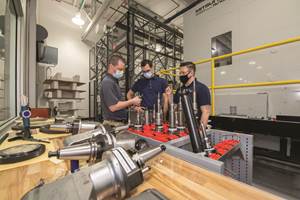Program Configures Complex Fixtures
Klune Industries is a $30-million, 170-employee job shop that produces products such as bomb racks, missile sections and numerous other complex structural components for both military and commercial aerospace applications.
Klune Industries, Utah division, is a $30-million, 170-employee job shop that produces products such as bomb racks, missile sections and numerous other complex structural components for both military and commercial aerospace applications. Founded in 1972, the company currently operates from a 180,000-square-foot facility where it runs an arsenal of 41 CNC machines, including several five-axis machines. Most of its parts, which run the gamut in size, are machined from materials such as 13-8 stainless, titanium, Hasteloy, Inconel,Waspaloy and aluminum. Fixtures are fabricated from a variety of tooling steels.
"We run part sizes that go from little pins and screws on our lathes up to parts that require us to use one of our four gantry mills," says cost estimator programmer Spencer LeFevre. "We run some missile sections that are 20 inches in diameter, but with our gantries they're no problem."
Klune produces many parts that might be considered fairly straightforward machining, but a large number of its parts have very complex shapes requiring multiple and highly complex fixtures. One factor complicating the part manufacturing process for Klune is that its customers tend to embellish their components, not only with complex contours, but with a variety of other features as well.
"Designers apparently love putting holes and pockets and surfaces and contours just about everywhere on their parts," Mr. LeFevre says, "which, of course, significantly adds to our fixturing problems, since we have to find ways to treat those features. On some parts we have to run seven fixtures to put in all the features."
Klune came to the CAD/CAM table about a decade ago. "We put together a committee of five engineers and programmers to pick out a CAD/CAM package," recalls Mr. LeFevre. In the end, the committee decided on SURFCAM, produced by Surfware, Inc. (Westlake Village, California).
"Before SURFCAM we were using calculators for computation and hand keying our programs directly into the machine controls. In those days we had to do a test run on a part to make sure we had it right, which was very expensive and time consuming. Now we use SURFCAM 2000's new Verify feature, which allows us to check our tool paths by running the actual posted G-Code. With the Verify feature we actually see the part machined right on the computer screen and, if we crash a tool, the software tells us. That feature alone saves us a lot of time and money. "
Mr. LeFevre says the SURFCAM Verify feature is particularly valuable on big parts. "On a big part, material costs can be significant," he says. "You definitely don't want to ruin an expensive piece of material with a faulty program. By using the Verify feature, we normally feel confident enough in our programs to just start running."
SURFCAM offers several features that are especially useful in the fixturing process, according to Mr. LeFevre. "Probably the most difficult are a couple of stringers and intercostals we build for the F-22," he explains. "There's not a straight surface on any of those parts, which means we have to fabricate them on our five-axis machines. One of our biggest headaches is designing and building the fixtures to hold the parts. Sometimes figuring out our fixtures is as tough as doing the parts themselves.
"Basically what happens is we get a solid model from our customer or we create one in SURFCAM's Design Plus," Mr. LeFevre explains. "Once we have the model, we use SURFCAM to visualize how we're going to hold the part, then we create a block around the finished solid to include enough material for whatever fixturing we have to do. After we figure out the first operation, we do the rest of the fixtures based on the requirements of the parts. We always use the same model on the parts and the fixtures, so we know we'll get a fit.
"The C Views feature allows us to create different orientations in the software without moving the solid," he says. "In C Views, we can assign each fixture operation to a different layer and color, which keeps things simple and uncluttered. If we want to, we can turn off all the layers except the one we're working on, which is very helpful on complex parts. SURFCAM also gives us the ability to move and translate and rebuild parts very quickly and easily, which saves considerable time."
Once Klune programmers are satisfied with a fixturing setup, they move to the final step of using SURFCAM to program machines to run both parts and fixtures. The Klune engineering and programming department has grown to 11 seats of SURFCAM, five dedicated to engineering and six to programming. "We basically use SURFCAM to do almost everything," says Mr. LeFevre. "We use SURFCAM to draw up the parts and the fixtures, then pass them on to our programmers to produce G-code in SURFCAM. The main thing we like is the software's drawing capability. SURFCAM makes it really fast and easy to draw an accurate tool path."
Related Content
Toolpath-Level Machine Monitoring Improves Aerospace OEE
Machine monitoring software that records historical efficiency to the toolpath level helped aerospace manufacturer Leesta improve its OEE by ten points.
Read MoreDigital Twins Give CNC Machining a Head Start
Model-based manufacturing and the digital thread enable Sikorsky to reduce lead times by machining helicopter components before designs are finalized.
Read More10 Things to Know About Creep-Feed Grinding
Because of the high material removal rate creep-feed grinding can deliver in challenging materials, grinding might not be just the last step in the process—it might be the process.
Read MoreIncreasing OEM Visibility to Shopfloor Operations for the Win
A former employee of General Motors and Tesla talks about the issues that led to shutdowns on factory lines, and what small- to medium-sized manufacturers can do today to win business from large OEMs.
Read MoreRead Next
The Cut Scene: The Finer Details of Large-Format Machining
Small details and features can have an outsized impact on large parts, such as Barbco’s collapsible utility drill head.
Read More3 Mistakes That Cause CNC Programs to Fail
Despite enhancements to manufacturing technology, there are still issues today that can cause programs to fail. These failures can cause lost time, scrapped parts, damaged machines and even injured operators.
Read More










.png;maxWidth=300;quality=90)
















